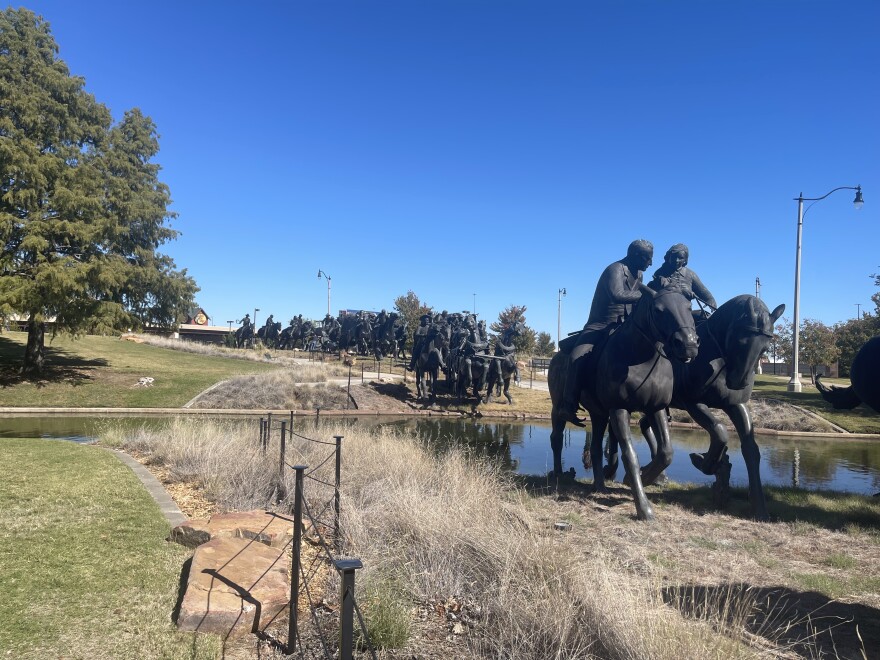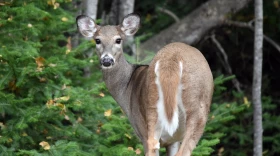Saying the current monument located at Centennial Park in Oklahoma City’s Bricktown "depicts the glorified embodiment of cavalier, colonial land theft at its finest. After forced relocation to Indian Territory, the federal government promised tribal nations they would never have to move again, and they would never have to cede additional lands…" a local group called SPIRIT (Society to Protect Indigenous Rights and Treaties) solicited input via community meetings, zoom calls and feedback from people via QR codes to envision a monument that tells the whole history of the land run.
The feedback around an alternative Land Run monument was presented to the Oklahoma City Planning Department and the Oklahoma Arts Commision in late December, as first reported in The Oklahoman. The report is called “Recontextualizing the Land Run Monument," and will include an Indigenous narrative.
Brenda Golden is a lawyer and a member of SPIRIT. She said they wanted information to present to the public. Demonstrations wouldn’t be enough.
"Without actual actual numbers and getting feedback from the public, it's hard to convince others that it's a widespread problem," said Golend. "And so this was the first step of a three phase project that is currently in the works, thanks to the cooperation from the city."
Golden credited the late Robbie Kienzle with helping SPIRIT apply for grant funds to complete this phase of the project. In 2021, Kienzle applied for and received a grant from Oklahoma
Humanities to engage scholars and Indigenous knowledge keepers to research and gather information, report the range of responses and then make recommendations for the second phase.
The next phase is for artists to submit proposals for what an additional narrative should look like. The project currently has $250,000 set aside for a final project. Golden said they need to get multiple perspectives on what an additional monument will look and feel like.
"Obviously we can't speak for all the experiences or historical perspectives that need to be addressed around the land run," Golden said. “I just can't explain enough how much input we need from the local community and the statewide communities…that's monumental step."

The 45 bronze sculptures are one of the largest public art projects in the country and were created by Paul Moore in 2015. Moore hails from Normanand has said that his ancestors participated in the land run.
The sculptures represent a day in 1889 when settlers rushed in to claim "unassigned" lands in Indian Territory. But, these lands were not unassigned.Tribal nations whose homeland was Oklahoma and those who had been removed on the brutal Trail of Tears were promised that this would be theirs "as long as the green grass grows and the water flows," according to treaties tribal nations signed after the Civil War.
Land run reenactments were and still are a part of Oklahoma's 4th grade curriculum. School children would dress up like pioneers and Indians and run to plant a flag in the ground to stake their claim on a piece of land that would be their homestead.
Like the musical Oklahoma!, the narrative around the Land Run plays into the mythology surrounding Oklahoma as an untouched place.
When people refer to the "unassigned lands" they're talking about particular land which was ceded to the United States by the Creek and Seminole Nations following the US Civil War. That was then declared unassigned as it was the one place in Indian territory that was not officially assigned to a tribal nation.
Oklahomans undoubtedly have heard of Oklahoma "Boomers" referring to Boomer Sooners, but they may not have learned about who Boomers were, what they did and how much they add to the "unassigned" land myth.
One of the most well known Boomers was David Payne. He and others would lead raids into Indian territory but would be escorted back out by Federal Marshalls. Scholars of Oklahoma history say the desire to be quickly ushered out was part of a larger plan to paint himself and others as victims-those who couldn't find any land to settle while trying to forcibly settle Native land. Native people saw this as an intrusion and part of a violent campaign of "sooners" trying to take possession of land promised to them.
In 2020, one Native OU student advocated for changing the name of a campus organization from Soonerthon to OU Dance Marathon because of what the name implied-in an article published in the OU Daily, he said he received hate mail.
In July of 2020, just days after the landmark McGirt v. Oklahoma decision, SPIRIT held a sit-in at the land run monument calling out its offensive nature. The group has been protesting Land Run monuments throughout the state since 2008.
SPIRIT said that collecting input from community members is the end of phase one of their plan to create an accompanying monument in Centennial Park.
Here's some of the responses they collected:
When you see images of the Land Run, how do they make you feel?
Phase one also asked people what they would like to see displayed near the centennial Land Run Monument site to educate tourists and park visitors from an Indigenous perspective?
- “It makes me feel like they are proud of what they did to my ancestors and that they're glorifying it. Many people don’t realize what had to take place in order for the land run to happen. I feel sorry and sad."
- “It feels like a celebration of colonization, of the stealing of Indigenous land and disenfranchisement of our people, and like a whitewashing of history that overlooks how that land came to be open for white settlers.
- One person said they wanted to, "create a space with Native art that celebrates our past, present, and future. QR codes that provide more historical context of the removal treaties. Prefer the sculptures to be removed. This was not an honorable act, show the truth."
Phase 2: Next Steps
- Arts Liaison and Project Team: Define the type of public art and/or public information marker that will best communicate the perspectives of Indigenous people regarding the LRM. Funding: Arts Liaison technical assistance time (General Fund)
- Arts Liaison and Parks and Recreation: Prepare the plaza site adjacent to the LRM for a new installation. Funding: Arts Liaison technical assistance time, and Parks Department
- Arts Liaison and Project Team: Issue an RFQ for design, fabrication, and installation of the marker. Funding: Arts Liaison technical assistance time
- Arts Liaison (project oversight): Construct the chosen design. Funding: Special fund for LRM
This report was produced by the Oklahoma Public Media Exchange, a collaboration of public media organizations. Help support collaborative journalism by donating at the link at the top of this webpage.









